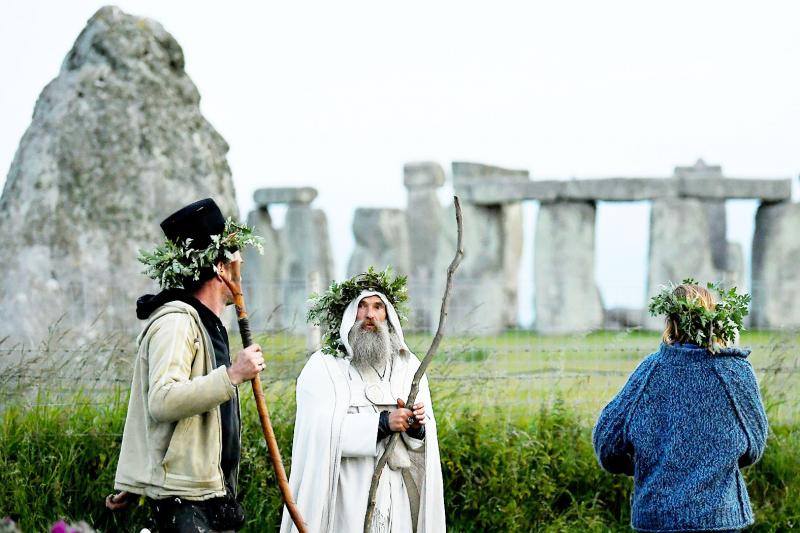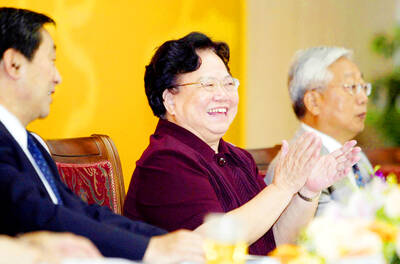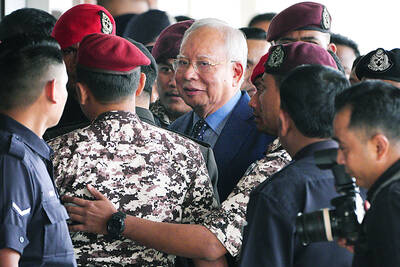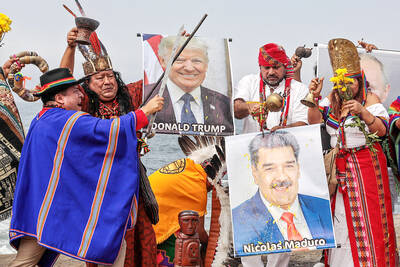A circle of deep shafts has been discovered near the world heritage site of Stonehenge, to the astonishment of archeologists, who have described it as the largest prehistoric structure ever found in the UK.
Four thousand five hundred years ago, the Neolithic peoples who constructed Stonehenge, a masterpiece of engineering, also dug a series of shafts aligned to form a circle spanning 2km in diameter.
The structure appears to have been a boundary guiding people to a sacred area, because Durrington Walls, one of the UK’s largest henge monuments, is located precisely at its center.

Photo: Reuters
The site is 3km northeast of Stonehenge on Salisbury Plain, near Amesbury, Wiltshire.
“This is an unprecedented find of major significance within the UK. Key researchers on Stonehenge and its landscape have been taken aback by the scale of the structure and the fact that it hadn’t been discovered until now so close to Stonehenge,” said Vincent Gaffney, a leading archeologist on the project.
The Durrington Shafts discovery, announced yesterday, is all the more extraordinary because it offers the first evidence that the early inhabitants of Britain, mainly farming communities, had developed a way to count. Constructing something of this size with such careful positioning of its features could only have been done by tracking hundreds of paces.
The shafts are vast, each more than 5m deep and 10m in diameter. About 20 have been found and there might have been more than 30. About 40 percent of the circle is no longer available for study as a consequence of modern development.
“The size of the shafts and circuit surrounding Durrington Walls is currently unique. It demonstrates the significance of Durrington Walls Henge, the complexity of the monumental structures within the Stonehenge landscape, and the capacity and desire of Neolithic communities to record their cosmological belief systems in ways, and at a scale, that we had never previously anticipated,” Gaffney said.
“I can’t emphasize enough the effort that would have gone in to digging such large shafts with tools of stone, wood and bone,” he added.
However, then these are the same people who also built Stonehenge, dragging bluestones to the site from southwest Wales about 241km away.
While Stonehenge was positioned in relation to the solstices, Gaffney said the newly discovered circular shape suggests a “huge cosmological statement and the need to inscribe it into the earth itself.”
“Stonehenge has a clear link to the seasons and the passage of time, through the summer solstice. But with the Durrington Shafts, it’s not the passing of time, but the bounding by a circle of shafts, which has cosmological significance,” he added.
The boundary might have guided people toward a sacred site within its center or warned against entering it.
As the area around Stonehenge is among the world’s most-studied archeological landscapes, the discovery is all the more unexpected.
Having filled naturally over millennia, the shafts — although enormous — had been dismissed as natural sinkholes and dew ponds. The latest technology — including geophysical prospection, ground-penetrating radar and magnetometry — showed them as geophysical anomalies and revealed their true significance.
“We are starting to see things we could never see through standard archeology, things we could not imagine,” Gaffney said.
Based at the University of Bradford, he is the co-principal investigator of the Stonehenge Hidden Landscape project, which has been surveying tens of kilometers of landscape across Salisbury Plain.
Archeologists are now joining the dots and seeing this massive pattern, he said.
Coring of the shafts has provided crucial radiocarbon dates to more than 4,500 years ago, making the boundary contemporary with Stonehenge and Durrington Walls.
The boundary also appears to have been laid out to include an earlier prehistoric monument, the Larkhill causewayed enclosure, built more than 1,500 years before the henge at Durrington.
Struck flint and unidentified bone fragments were recovered from the shafts, but archeologists can only speculate how those features were once used.
“What we’re seeing is two massive monuments with their territories. Other archeologists, including Michael Parker Pearson at University College London, have suggested that while Stonehenge, with its standing stones, was an area for the dead, Durrington, with its wooden structures, was for the living,” Gaffney said.
While numerous ancient civilizations had counting systems, the evidence lies primarily in texts in various forms that they left behind, he added.
The planning involved in contracting a prehistoric structure of this size must have involved a tally or counting system, he said.
Positioning each shaft would have involved pacing more than 800m from the henge outward.
The research has involved a consortium of archeologists, led by the University of Bradford, and including the universities of Birmingham and St Andrews, in an international collaboration with the Ludwig Boltzmann Institute for Archaeological Prospection and Virtual Archaeology at the University of Vienna.
Henry Chapman, professor of archeology at Birmingham University, described it as “an incredible new monument,” and Richard Bates, a geoscientist at St Andrews University, said it offered “an insight to the past that shows an even more complex society than we could ever imagine.”

The death of a former head of China’s one-child policy has been met not by tributes, but by castigation of the abandoned policy on social media this week. State media praised Peng Peiyun (彭珮雲), former head of China’s National Family Planning Commission from 1988 to 1998, as “an outstanding leader” in her work related to women and children. The reaction on Chinese social media to Peng’s death in Beijing on Sunday, just shy of her 96th birthday, was less positive. “Those children who were lost, naked, are waiting for you over there” in the afterlife, one person posted on China’s Sina Weibo platform. China’s

‘NO COUNTRY BUMPKIN’: The judge rejected arguments that former prime minister Najib Razak was an unwitting victim, saying Najib took steps to protect his position Imprisoned former Malaysian prime minister Najib Razak was yesterday convicted, following a corruption trial tied to multibillion-dollar looting of the 1Malaysia Development Berhad (1MDB) state investment fund. The nation’s high court found Najib, 72, guilty on four counts of abuse of power and 21 charges of money laundering related to more than US$700 million channeled into his personal bank accounts from the 1MDB fund. Najib denied any wrongdoing, and maintained the funds were a political donation from Saudi Arabia and that he had been misled by rogue financiers led by businessman Low Taek Jho. Low, thought to be the scandal’s mastermind, remains

Australian Prime Minister Anthony Albanese yesterday announced plans for a national bravery award to recognize civilians and first responders who confronted “the worst of evil” during an anti-Semitic terror attack that left 15 dead and has cast a heavy shadow over the nation’s holiday season. Albanese said he plans to establish a special honors system for those who placed themselves in harm’s way to help during the attack on a beachside Hanukkah celebration, like Ahmed al-Ahmed, a Syrian-Australian Muslim who disarmed one of the assailants before being wounded himself. Sajid Akram, who was killed by police during the Dec. 14 attack, and

Shamans in Peru on Monday gathered for an annual New Year’s ritual where they made predictions for the year to come, including illness for US President Donald Trump and the downfall of Venezuelan President Nicolas Maduro. “The United States should prepare itself because Donald Trump will fall seriously ill,” Juan de Dios Garcia proclaimed as he gathered with other shamans on a beach in southern Lima, dressed in traditional Andean ponchos and headdresses, and sprinkling flowers on the sand. The shamans carried large posters of world leaders, over which they crossed swords and burned incense, some of which they stomped on. In this